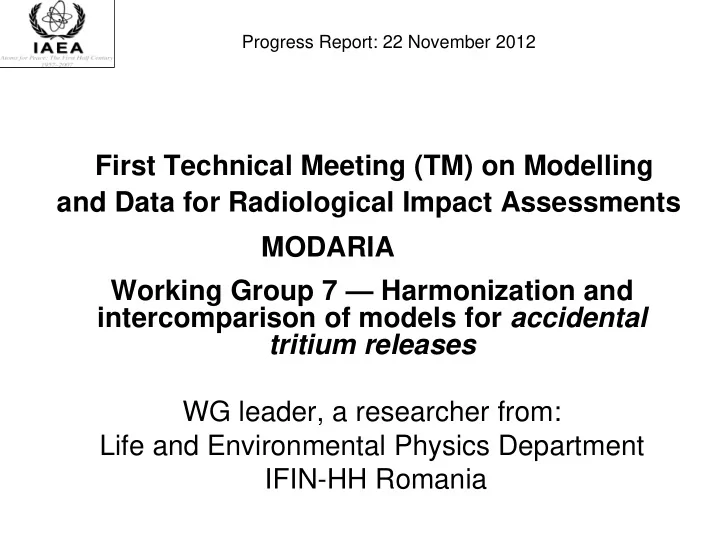

Progress Report: 22 November 2012 First Technical Meeting (TM) on Modelling and Data for Radiological Impact Assessments MODARIA Working Group 7 — Harmonization and intercomparison of models for accidental tritium releases WG leader, a researcher from: Life and Environmental Physics Department IFIN-HH Romania
Participants- attendance • 4 from FRANCE (IRSN, EDF, CEA) • 3 from CANADA (CRL, CNSC) • 2 from Romania (IFIN-HH) • 1 from Japan (JAEA) • 1 from Bulgaria (Kozlodui NPP) • And visitors • MODELS: CRL, IFIN-HH,IRSN, JAEA, CEA (?)
(distributed tasks Nov 2012) Analysis of the transfer of tritium in terrestrial ecosystems • Interception of wet deposited tritium by plant canopies and uptake by leaves (CEA(?)+IFIN-HH)-May 2013 • Uptake of tritium by vegetated and non-vegetated soil (CRL) May 2013 • Transfer of tritiated water (HTO) and the dynamics of HTO in the soil – plant – atmosphere complex (IFIN-HH) • Re-emission of HTO from soil as a secondary source (CNSC) May 2013 • Formation of organic bound tritium (OBT) at night (IFIN-HH)-Draft hypothesis Nov 2013 • Oxidation of OBT during preparation and storage of feed and food (CRL)-May 2013 • Turnover of OBT in litter and soil (JAEA) May 2013 • Specification of IRSN experimental design and Pasture model (IRSN) May 2013 • Specification for an accidental tritium model (CNSC, NPP Kozlodui) May 2013 • Emergency response - time for first reported values (NPP Kozlodui) May 2013 • OBT/HTO ratios and fate of tritium - new data (CNSC) May 2013
Inter-comparison of models for specific scenarios • Dry or wet deposition of tritium following dry or wet weather periods; PASTURE scenario Nov 2013-IFIN-HH And participants, only DAY • Dry and wet deposition of tritium during the day and during the night; postponed for 2014 • Dry and wet deposition of tritium during different seasons. Partially for PASTURE • FLUCTUATING TRITIUM RELEASE CRL-nov 2013
Guidance for application of environmental tritium models • Uncertainty analysis and testing against experimental data; >> see constraints • Exploring possibilities for model simplification; AFTER we analyze models • Exploring the need for site-specific data; MANDATORY for applicability of the model • Links to atmospheric transport models; country specific for RIA • Application to fluctuating tritium release , on going
Developing experiments in support of model (IRSN project) • The main objective of this project is to better understand and quantify the transfer processes of tritium from the atmosphere (air and rainwater; tritiated hydrogen (HT)/HTO) to grass and soil Partially cover the needs for ITER • In order to address the enormous range of factors that affect the transfer of tritium (e.g. humidity in air and soil, temperature, current and recent rainfall, season, stage of growth etc.), the IRSN project will carry out high frequency (daily) sampling in air, rainwater and soil to reduce uncertainties of tritium transfer coefficients. • NOTE: on dynamics we have transfer RATES
Results (see CONSTRAINTS) • Peer reviewed papers on improved modelling aspects and model comparison exercises (by each major participant)>2014 CRL and IFIN-HH, based on WG contribution • Technical report on the compilation of parameters to quantify environmental transport processes (if possible) • Report on the analysis, tests and comparison of models developed for the transfer of tritium in the environment (if more models will be available) • Technical report containing guidance for the application of improved and harmonized models for tritium ( much latter) • Peer reviewed papers and model documentation for IFIN-HH actual project (2014)
CONSTRAINTS • NO available experimental data for a tritium only accident • Difficulties for splitting by processes and analysis of each contribution to final robustness (for ingestion-inhalation dose) • Uncertain understanding of uncertainties • No well designed new experiment-model oriented • NO experiments planned in 2013 for OBT in night • Models as toys or tools for practical application? • Models and experiments ARE NOT DISTINCT professions • How we can obtain the simpler complex model??? (see Einstein) • Solveg to complex, TOCATTA under development only for pasture
COMPENSATORY ERRORS USER INFLUENCE A modellers’ view on uncertainty (taken from [van Asselt 1999])
Links with other WG Daily routine 14 C release Daily ROUTINE Tritium release ROUTINE RELEASE IS FLUCTUATING RELEASE
Non-human biota Generalized coordinates: 1 lemming - normalized concentration chipmunk (same per kg whole body) rabbit red fox - non dimensional time normalised concentration red deer (use scaling with average duck 0.1 metabolic rate) We can provide Static and dynamic models 0.01 For non-human biota 14C and 3H- OBT 0.001 0 5 10 15 20 25 30 T*RMR
Alternative I
Alternative II
Recommend
More recommend